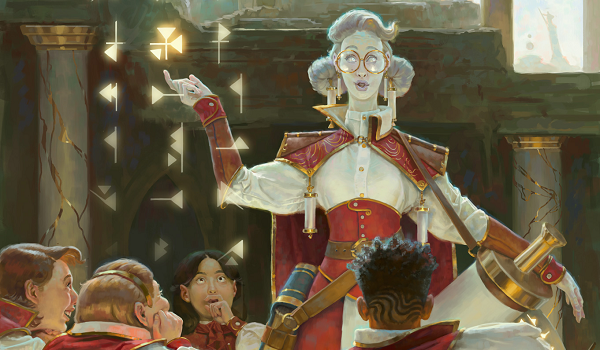Are you a Quiet Speculation member?
If not, now is a perfect time to join up! Our powerful tools, breaking-news analysis, and exclusive Discord channel will make sure you stay up to date and ahead of the curve.
How does one measure the unmeasurable? I'm not being facetious or rhetorical. That was an actual question. It's something that analysts in many capacities must struggle with alongside quantifying the unquantifiable and persuading the unpersuadable. The struggle is very, very real. I bring this up because it's been awhile since I really dove into the health of Modern. Measuring format health is simultaneously easy and almost impossible. On one extreme, sick and broken metagames are easy to identify. However, as the format gets healthier, the degree of health gets increasingly ambiguous. Which makes it increasingly hard to measure and discuss.
I've been meaning to include this discussion in the metagame updates for awhile now. However, those articles are long enough already. Coupled with the above discussed problem this keeps getting shoved onto the back burner. It's nonetheless very important that I finally get around to writing this article because Modern is in a very strange place. Since Wizards blasted away Modern's problems back in February the format has been quite dynamic, innovative, and most importantly, diverse. This should lead to higher player satisfaction. However, I've been hearing very polarized views on the new Modern which have gotten worse since MH2. Many players think that Modern's never been better. A roughly equivalent number think the exact opposite.
It's odd to see such polarized opinions, but I think I know why. Today, I'll argue that Modern is by most measures quite healthy. However, it's so different from before that many players feel alienated.
Measuring Health
Metagame health is something every player understands intuitively, but can't really quantify. Proverbially, we know it when we see it. Of course, no two people ever fully agree on anything, and so everyone's exact definition of health will differ. There are those perfectly fine with really busted decks so long as they're fun to play and others that want to ban until 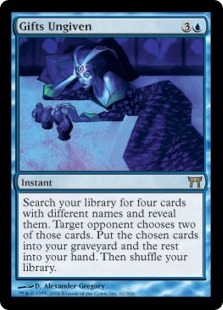 their pet deck is good... no matter how unrealistically drastic the measures would need to be. (5-Color Gifts Reanimator Control is, always has been, and always will be bad <redacted>. Let. It. Go!) Naturally, these are personal opinions. We'll require something more concrete to go on.
their pet deck is good... no matter how unrealistically drastic the measures would need to be. (5-Color Gifts Reanimator Control is, always has been, and always will be bad <redacted>. Let. It. Go!) Naturally, these are personal opinions. We'll require something more concrete to go on.
Fortunately, I and many other writers and commenters (including some on this very site) have been thinking and commenting on this problem for years and have come to consensus on certain criteria. We're not doctors, and the metagame is not our patient, let alone a physical being at all. So we lack a checklist or test that will scientifically diagnose a metagame problem. However, we do know what makes a metagame unhealthy, and can use the opposite of that to measure health. From experience and consensus, the unhealthy formats are ones with low diversity which are stagnant and uncompetitive. Therefore, healthy formats are diverse, dynamic, and competitive.
Metagame Diversity
This is the most commonly cited metric, but it can be a bit squishy: while everyone wants a diverse and interesting metagame, diversity is relative. A format with only 5 total decks may or may not be diverse depending on the context. If only 7 decks are plausible (as used to happen in Block Constructed), then that 5-deck metagame is quite diverse. If instead 20 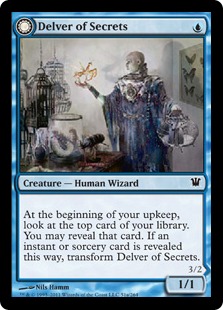 decks are possible, then the 5-deck metagame would be fairly narrow. There's no way to definitively say how many decks are possible in a format like Modern (and may not even be possible for Standard). Fortunately, another reasonable way to measure diversity is whether there are a large number of decks with distinctive gameplay.
decks are possible, then the 5-deck metagame would be fairly narrow. There's no way to definitively say how many decks are possible in a format like Modern (and may not even be possible for Standard). Fortunately, another reasonable way to measure diversity is whether there are a large number of decks with distinctive gameplay.
That last point is the most important to me. A format with 20 viable decks sounds quite diverse. But if they're all variants on the same theme, then the diversity is artificial, because every game feels extremely similar. This has happened several times with Delver of Secrets. Innistrad-era Standard was primarily made up of variations on UW Delver, while Legacy has seen several periods where URx Delver was best and most widespread deck. Exactly which color filled the x slot varied over the course of the year, but that didn't sufficiently change the essential sameness of the decks. Diversity is not just a lot of decks with different names but similar deck lists; it requires actually unique gameplay between the decks.
Dynamism
However, having a lot of different decks isn't enough. There needs to be metagame dynamism. Decks can't just hang around forever; there should be growth and change. In a dynamic metagame, the exact composition of the metagame changes over time as new 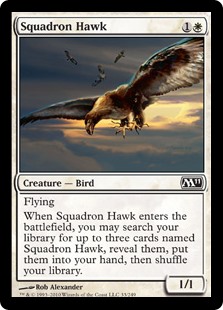 strategies rise to answer existing decks, succeed, and are in turn challenged by new decks. Static formats get boring quickly, since there's no answer to the best decks, and things settle around the best established strategy and its counters.
strategies rise to answer existing decks, succeed, and are in turn challenged by new decks. Static formats get boring quickly, since there's no answer to the best decks, and things settle around the best established strategy and its counters.
Which is exactly what playing chess is like. That game has so many established openings, counters, and counter-counter strategies that it's somewhat robotic. Once your opponent establishes a given strategy, there already exists a counter, and the game from that point becomes about who best executes the known strategies. True innovation is quite rare. That is great for masters but hard on everyone else. And Magic isn't chess, so I'll argue that when the game becomes chess-like, it becomes less healthy (which was the problem with Standard Cawblade).
Competitiveness
The final criteria, building on the idea of dynamism, is competitiveness. It's not enough for the overall metagame to gradually cycle. There should be turnover in the event standings, too. If the same few decks (or worse, one deck) win every event, then it really doesn't matter that many 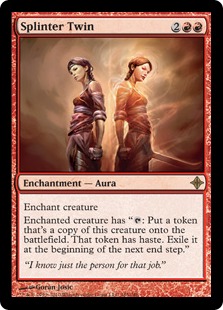 other decks win games and the format is constantly moving. There might as well only be those top few decks. In a healthy metagame, there would be certain decks that are better than the others. It has to happen because cards aren't equal nor see equal play. However, those best decks shouldn't be so much better that other decks can't consistently beat them. It's fine if they show up more than other decks, but not if other decks don't consistently place high in a format.
other decks win games and the format is constantly moving. There might as well only be those top few decks. In a healthy metagame, there would be certain decks that are better than the others. It has to happen because cards aren't equal nor see equal play. However, those best decks shouldn't be so much better that other decks can't consistently beat them. It's fine if they show up more than other decks, but not if other decks don't consistently place high in a format.
This is ultimately the reason that Splinter Twin was banned. It didn't meaningfully restrict diversity and the metagame did cycle around Twin. However, Twin won events. Far more events than any other deck in its era. It won half the Modern Pro Tours and far more Grand Prix than any other deck. That was effectively stagnating growth and change because while other decks could compete, the playing field was slanted towards Twin. It's healthier when many decks are able to take the top slots.
A Clean Bill
Taking the above criteria and applying it to Modern leads me to say that the format is quite healthy. The metagame updates since March have shown that fairly clearly. To wit:
- Metagame Diversity: Modern has had an average of 17.8 decks make the tier list, with a high of 23 and low of 13. These decks make up a fraction of the total decks that appear in results. Every deck plays quite differently from each other despite card overlap and many strategies are viable. The metagame is quite open.
- Dynamism: The best decks in March were Jund Shadow, Heliod Company, Mono-Green Tron, Amulet Titan, Death and Taxes, and Izzet Prowess. The current list is Hammer Time, UW Control, UR Thresh, Burn, Cascade Crashers, Jund Saga, Elementals, and Living End. Modern is showing considerable dynamism overall, and even month-to-month decks are rising and falling in all tiers.
- Competitiveness: This has varied highly over the past year. May was a very non-competitive month. However, that was corrected shortly afterward and the most recent data shows many decks doing well. I will attest that October is continuing the trend of decks of all tiers winning events and/or placing highly. Thus, Modern is quite competitive right now and has overall been very competitive this year.
The data I've collected very clearly shows that Modern is overall in a very healthy spot. The top tiers are no longer so dominant that other decks can't win and there is constant evolution between tier composition while diversity has been quite high. On a more qualitative level, I can't see how formats where Burn and UW Control (two extremely fair decks) are Tier 1 can't be healthy.
Those Dissatisfied
All that said, there is one other constantly cited criterion: it's fun. If the format isn't fun then nothing else matters. We're playing a game, and games are intended to be fun. If they are not, then other measures of quality don't actually matter (looking at you, Escape from Tarkov). However, fun isn't objective; it's personal and therefore unmeasurable. What is fun for one person is  excruciatingly boring to another (now looking at you, Lantern Control). Consequently, the most important consideration is not one that can really be argued over and is even harder to quantify and critique. Consequently, every metagame has its detractors and simply saying that not every player enjoys the format the same is unhelpfully meaningless. Because no duh, they don't!
excruciatingly boring to another (now looking at you, Lantern Control). Consequently, the most important consideration is not one that can really be argued over and is even harder to quantify and critique. Consequently, every metagame has its detractors and simply saying that not every player enjoys the format the same is unhelpfully meaningless. Because no duh, they don't!
However, what's interesting this time is the form the complaints are taking. As mentioned earlier, as many players seem to dislike this metagame as enjoy it. Most of the complaints point back to developments since MH2, but unlike last time, it's not really about cards being too powerful. Rather, there are a lot of players arguing that certain cards should not exist, regardless of whether they think the cards are oppressive or overpowered. Saying cards should never be is nothing new (Teferi, Time Raveler says hello), but that's usually as a function of it being oppressive against a deck or too powerful. The most common thread I hear is that the cards that shouldn't exist from MH2 shouldn't exist because they make Modern not feel like Modern.
Modern's Gone a Bit "Legacy"
 By which said players almost always mean that Modern feels more like Legacy now. And while I don't necessarily agree, I understand the sentiment. Legacy has always been the format of tempo and card selection. Brainstorm, Ponder, and Preordain are all legal, and consequently most decks are based around cantripping through their decks looking for the right spell for the current situation. Subsequently, every deck seeks to maximize its mana efficiency and minimize dead draws by playing only cheap spells and as few lands as possible. Games are won either by tempo-ing the opponent out of the game or by cantripping into the right spells to win. Additionally, raw card advantage is far more prevalent and wins games.
By which said players almost always mean that Modern feels more like Legacy now. And while I don't necessarily agree, I understand the sentiment. Legacy has always been the format of tempo and card selection. Brainstorm, Ponder, and Preordain are all legal, and consequently most decks are based around cantripping through their decks looking for the right spell for the current situation. Subsequently, every deck seeks to maximize its mana efficiency and minimize dead draws by playing only cheap spells and as few lands as possible. Games are won either by tempo-ing the opponent out of the game or by cantripping into the right spells to win. Additionally, raw card advantage is far more prevalent and wins games.
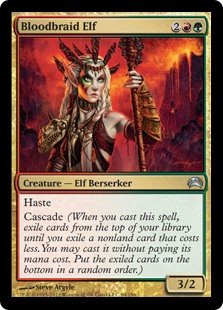 By contrast, for a long time none of that was possible in Modern. Raw card advantage was more expensive and cantrips were few and far between, so decks had to be more redundant. Modern decks weren't going to see too many cards each game, and so they had to maximize the impact of each individual card. It's why Jund was so successful for so long and why Grixis Shadow was so feared back in 2017. It played a lot of cantrips, a low number of lands and threats, a low curve, and was built around card advantage, all Legacy traits. It was unheard of for Modern and looked like a huge turning point. Then 2018 happened and all those fears went away.
By contrast, for a long time none of that was possible in Modern. Raw card advantage was more expensive and cantrips were few and far between, so decks had to be more redundant. Modern decks weren't going to see too many cards each game, and so they had to maximize the impact of each individual card. It's why Jund was so successful for so long and why Grixis Shadow was so feared back in 2017. It played a lot of cantrips, a low number of lands and threats, a low curve, and was built around card advantage, all Legacy traits. It was unheard of for Modern and looked like a huge turning point. Then 2018 happened and all those fears went away.
Only to resurface in June when MH2 gave Modern Ragavan, Nimble Pilferer, Murktide Regent, and Dragon's Rage Channeler. These cards combined to push Izzet decks away from the very Modern Izzet Prowess and towards the very Legacy UR Thresh, a deck that looks like Delver and plays like Legacy's classic Thresh decks (hence the archetype name being more specific than simply UR Tempo). In turn, it's incentivizing a lot of players to lower their curves, Legacy-style, to compete. It's everything that Modern wasn't and that's alienating players.
And That's By Design
Unfortunately for those alienated players, that's not going to change. This is what Wizards wants. It's why Ragavan and company were designed that way. The deck changes caused by MH2 were what Wizards was going for because that's where their design is heading, not just for Modern, but Standard too.
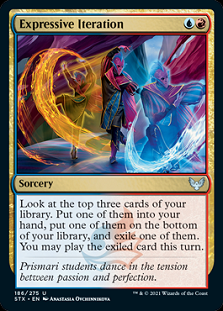 Those familiar with Mark Rosewater's blog can attest: Wizards is looking for ways to make it easier to play with more cards in a game of Magic. Despite what it sometimes seems, Wizards wants players to play with their cards. As many as possible per game. They had been trying to accomplish this by deliberately slowing Standard down circa Battle for Zendikar, but it didn't really work out. The games tended to stalemate for snowball out of control and players didn't like that. Combined with pressure from Commander players, now they're looking to improve each color's card flow and mana development so that more cards are drawn and cast per game.
Those familiar with Mark Rosewater's blog can attest: Wizards is looking for ways to make it easier to play with more cards in a game of Magic. Despite what it sometimes seems, Wizards wants players to play with their cards. As many as possible per game. They had been trying to accomplish this by deliberately slowing Standard down circa Battle for Zendikar, but it didn't really work out. The games tended to stalemate for snowball out of control and players didn't like that. Combined with pressure from Commander players, now they're looking to improve each color's card flow and mana development so that more cards are drawn and cast per game.
This is why there's been an increase in cheap card draw and cantrips, with treasure tokens going evergreen. Wizards can't maintain the Color Pie by just giving every color everything, so they looked for a way around it. Improving access to cards is why red's been getting Light Up the Stage and similar cards in such quantity, Opt and now Consider are constantly in Standard; green has so many cantrip creatures; and white is getting (still very weak) card advantage. Treasure is a way to provide temporary mana ramp so that non-green colors can keep up and sometimes jump ahead. It's the reason that Expressive Iteration lets players play the exiled card. Wizards apparently likes Legacy's card flow and mana cheating, if at a lower power level.
Where Does This Lead?
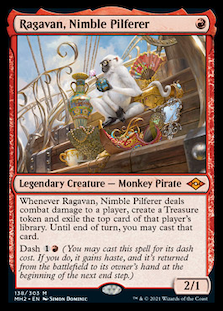 The design philosophies that led to all of the complaints will be in place for the foreseeable future. Not necessarily because they've proven successful or popular (only Wizards knows that), but because sets are designed about two years ahead of release. Even if things are looking glum from a response standpoint, Wizards can't dramatically change course now. And after that, it's hard to say. A lot of the discourse around the recent World Championship has been critical of those decisions. Alrund's Epiphany may be oppressive in Standard (or not) but everyone appears to agree that the deck just never runs out of cards and the real power is how it generates treasure tokens. In other words, those things Wizards are pushing right now appear to be dangerous for Standard. This may lead to a doctrinal change down the line or it might not. But in any case, this is the world we must live in, like it or not.
The design philosophies that led to all of the complaints will be in place for the foreseeable future. Not necessarily because they've proven successful or popular (only Wizards knows that), but because sets are designed about two years ahead of release. Even if things are looking glum from a response standpoint, Wizards can't dramatically change course now. And after that, it's hard to say. A lot of the discourse around the recent World Championship has been critical of those decisions. Alrund's Epiphany may be oppressive in Standard (or not) but everyone appears to agree that the deck just never runs out of cards and the real power is how it generates treasure tokens. In other words, those things Wizards are pushing right now appear to be dangerous for Standard. This may lead to a doctrinal change down the line or it might not. But in any case, this is the world we must live in, like it or not.
The Only Constant Is Change
I sympathize with the players who feel left out by Wizards' new course. It is a huge deviation from old patterns and it does mean that old strategies must heavily adapt. This isn't inherently bad, and in some ways makes for a more interesting and dynamic format. It's just not fun for everyone. If you don't like it, I'm sorry. You can vote against it with your wallet, but Wizards's sales figures may continue to vote against you. Healthy? You tell me!


